Villagers in the South Pacific adore a mysterious American they call John Frum, and believe he will one day flood their remote island with riches..
di Marco Maculotti
Translation of the article In John They Trust
by Paul Raffaele, originally published
in the Smithsonian Mag in February 2006
In the morning heat on a tropical island on the other side of the world from the United States, several dark-skinned men, dressed in what appear to be US Army uniforms, appear on a mound overlooking a bamboo hut village. One carries the old woman with reverence Old glory, the stars and stripes flag, precisely folded to show only the stars. Under the command of a bearded "drill sergeant", the flag is raised on a pole cut from a tall tree trunk. As the huge banner flutters in the wind, hundreds of villagers cheer and watch each other applaud. Chieftain Isaac Wan, a thin, bearded man in a blue suit and sash, leads the men in uniform to an open space in the middle of the village. About forty barefoot men suddenly emerge from behind the huts in general acclamation, marching in unison. They carry bamboo "rifles" on their shoulders, the scarlet tips sharpened to represent bloody bayonets, and sport the letters "USA" painted in red on the chest and back.
It is February 15, the John Frum Day, on the remote island of Tanna in the nation of Vanuatu, in the South Pacific. On this holy day, devotees came to Lamakara village from all over the island to honor a ghostly American messiah, John Frum. "John promised he'll bring us planes and loaded ships from America if we please," a village elder tells me as he greets the Stars and Stripes. "Radio, TV, trucks, boats, watches, refrigerators, medicines, Coca-Cola and many other wonderful things." The cult movement involving John Frum is a classic example of what anthropologists have called Cargo cults, especially common in South Pacific villages during World War II, when hundreds of thousands of American soldiers poured into the islands from the skies and seas.
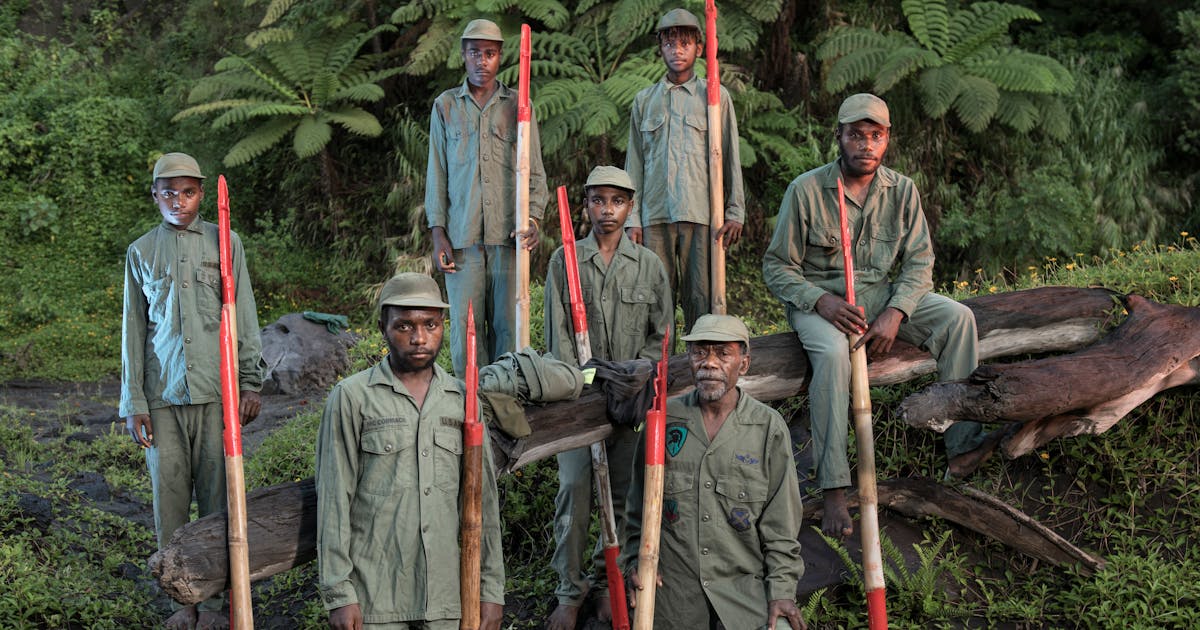
As anthropologist Kirk Huffman, who spent 17 years in Vanuatu, explains: "Cargo cults arise when the outside world, with all its material wealth, suddenly descends upon remote indigenous tribes." The locals do not know where the endless supplies of strangers come from and therefore suspect that they have been summoned by magic, sent directly from the spirit world. To entice Americans to return after the war, islanders across the region built piers and carved airstrips in their fields. They prayed that ships and planes would come out of nowhere again, carrying all kinds of treasures: jeeps and washing machines, radios and motorcycles, tinned meat and candy.
But the revered Americans never returned, except as a handful of tourists and veterans eager to visit again the distant islands where they went to war in their youth. And although nearly all the Cargo Cults have disappeared over the decades, the John Frum movement has resisted, based on the worship of an American god that no man here has ever seen. Many Americans have known Vanuatu since reality TV Survivor, although the episodes filmed there have hardly touched the spectacular natural wonders and fascinating centuries-old cultures of the island nation of Melanesia. Located between Fiji and New Guinea, Vanuatu is a Y-shaped scattering of more than 80 islands, many of which include active volcanoes. The islands were once home to ferocious warriors, some of them cannibals. Many villagers still resort to village sorcerers, who use spirit-animated stones in magical rituals to lure a potential lover, fatten a pig, or kill an enemy.

Americans with more distant memories remember Vanuatu as the New Hebrides, its name until its independence from British and French colonial rule in 1980. James Michener's book Tales of the South Pacific, which then gave birth to the musical South Pacific, was born from his experiences as an American sailor in the New Hebrides during World War II. My experience in the South Pacific, in search of John Frum and his devotees, begins when I board a small plane in Vanuatu's capital, Port-Vila. Forty minutes later, coral reefs, sandy beaches and green hills herald the island of Tanna, some 20 miles long and 16 miles long at its widest point, with a population of around 28.000. Climbing into an old jeep to go to Lamakara, which overlooks Sulfur Bay, I wait for Jessel Niavia, the driver, to set the vehicle in motion by tapping together two wires protruding from a hole under the dashboard.
As the jeep climbs up a steep slope, the narrow path that cuts through the dense green texture of jungle trees and bushes, Jessel tells me he's the brother-in-law of one of the most important leaders of the cult, the prophet Fred, who, he adds proudly, "raised his wife from the dead two weeks ago." When we reach the crest of a hill, the land before us disappears to reveal Yasur, the sacred volcano of Tanna, a few miles to the south, its ash-covered slopes that push the shoreline to Sulfur Bay. Dark smoke erupts from its cone. "'Yasur' means God in our language," Jessel murmurs. "It is John Frum's home". "If he is American, why does he live in your volcano?" I wonder aloud. "Ask Chief Isaac," he says. "He knows everything." Dotting the dirt road are small villages where women with bubble-shaped curly hair crouch on bundles of mud-covered roots called kava, a kind of pepper plant and a mediocre narcotic that is the South Pacific's favorite drug. Connoisseurs say that the kava of Tanna is the strongest of all. Jessel buys a package of roots for 500 vatu, about $ 5. "We'll drink it tonight," she says with a smile.

For as long as the inhabitants of Tanna have remembered it, the men of the island have collected it kava at sunset, in a place forbidden to women, every single day. Christian missionaries, mostly Presbyterians from Scotland, temporarily stopped the practice in the early XNUMXth century, also banning other traditional practices, or kastom, which the locals had followed faithfully for millennia: dance, penis wrapping, and polygamy. The missionaries also prohibited work and entertainment on Sundays, swearing and adultery. In the absence of a strong colonial administrative presence, they set up their own courts to punish evildoers, sentencing them to hard labor. The Tannians simmered under the rule of the missionaries for three decades. Then John Frum appeared.
The road descends steeply through a wetter jungle to the shoreline, on the way to Yasur, where I will be staying in a beach hut. As the sun sets over the rainforest-covered mountains that form Tanna's backbone, Jessel's brother Daniel Yamyam arrives to pick me up. He has the tender eyes and the almost toothless smile of a devoted consumer of kava. Daniel was once a member of the Vanuatu parliament in Port-Vila, and his voters included followers of John Frum from what was then the stronghold of the movement, Ipikil, in Sulfur Bay. “I'm a Christian now, but like most people on Tanna, I still have John Frum in my heart,” he says. "If we keep praying to John, he'll come back with a rich load."
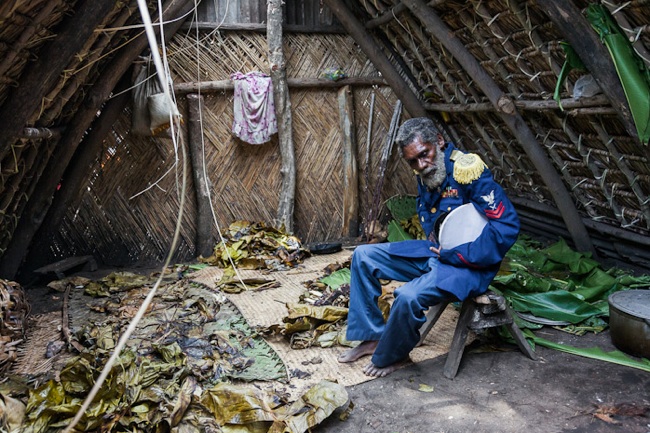
Daniel leads me to the nakamal, the open ground where men drink kava, of the village. Two young boys lean over the roots of kava that Jessel had bought, chewing bits into a fibrous pulp. “Only circumcised boys who have never touched a girl's body can do the kava», Daniel tells me. "This ensures their hands aren't dirty." Other guys mix the water with the pulp and swirl the mixture through a cloth, producing a cloudy looking liquid. Daniel hands me a half coconut shell filled to the brim. "Drink it all at once," he whispers. It tastes repulsive, like muddy water. Moments later my mouth and tongue go numb. Men divide into small groups or sit alone, squatting in the dark, whispering to each other or lost in thought. I knock down a second shell of the muddy mixture and my head pulls its mooring, trying to slip away into the night.
Yasur thunders like distant thunder, a couple of miles over the ridge, and through the trees I glimpse a mysterious red glow at the top of its cone. In 1774, the captain James Cook he was drawn ashore by that same glow. He was the first European to see the volcano, but local leaders banned him from climbing to the summit because it was considered taboo. Daniel assures me that the taboo is no longer applied. "Go with Chief Isaac," he advises. "You can ask him tomorrow." After drinking my third shell of kava, Daniel scrutinizes my undoubtedly glassy eyes. "You better take it back," he says. On the seashore, in my hut, I dance unstable to the rhythm of the waves as I try to tear the sparkling moon from the sky and kiss it. The next morning, I head to Lamakara to speak with Chief Isaac. Surrounded by a apocalyptic lunar landscape of volcanic ash, Yasur looms behind the village. But at only 1184 feet high, the sacred volcano has none of the majesty, say, of Mount Fuji; rather, his squat form reminds me of a pugnacious bulldog standing guard in front of his master's house. My driver points to the cone. "Haus blong John FrumHe says in English pidgin. That's John Frum's house.

In the village dozens of reed huts, some with rusted tin roofs, surround an ash-strewn ceremonial ballroom and the mound upon which the American flag flies every day, flanked by the much smaller flags of Vanuatu, that of colonial France and that of the Australian Aborigines, whose drive for racial equality is much admired by the villagers. Clearly, John Frum has yet to return with the promised cargo, because Lamakara is poor in consumer goods. But the men of the island, wrapped in a cloth known as washes-washes, women in long floral dresses and mostly barefoot and t-shirted children look healthy and happy. It's no surprise: Like many South Pacific coastal villages, Lamakara is a place where coconuts drop close to you as you sleep under palm trees. Yams, taro, pineapple and other fruits thrive in the fertile volcanic soil, and plump pigs sniff around the village for leftovers. Tasty fruit bats cling upside down on nearby trees.
Chief Isaac, in an open-necked shirt, green trousers and cloth shoes, greets me on the mound and leads me to a hut behind the flagpoles: John Frum's inner sanctuary, off limits to all but sect leaders and, it seems, male visitors from abroad. "Office blow meHe says with a smile as we enter. The hut is dominated by a round table displaying a small United States flag on a pedestal, a sculpted bald eagle and imitations of US military uniforms neatly folded and arranged in a circle, ready for use on John Frum Day from there to just over a week. Above, suspended by a screw from a beam, hangs a globe, a stone ax, and a pair of green stones carved into circles the size of a silver dollar. "Very powerful magic," says the chief, pointing to the stones. "The gods created them a long time ago."

Written on a couple of blackboards is a plea that John Frum's followers lead a life kastom and that they refrain from violence against each other. One of the blackboards bears a red cross made in chalk, probably copied from US military ambulances and now an important symbol for worship. «John Frum came to help us recover our traditional customs, our drinking kava, our dances, because the missionaries and the colonial government were deliberately destroying our culture "says Chief Isaac in his English pidgin translated by Daniel. “But if John Frum, an American, will bring you modern goods, as it accords with his desire to lead a life kastom? », I ask. “John is a spirit. He knows everything ", says the chieftain, overcoming the contradiction with the balance of an experienced politician. "He is even more powerful than Jesus".
"Have you ever seen it?". "Yup, John comes to Yasur very often to advise me, or I go there to talk to John". "What does it look like?" "As an American!" "So why does he live in Yasur?" "John moves from America to Yasur and returns, descending through the volcano and under the sea". When I speak of the Prophet Fred, anger flares up in the eyes of Chief Isaac. "He's a devil," he growls at him. "I'm not talking about him." "What about your visit to the United States in 1995?" I ask. "What do you think of the earthly paradise of your religion?" He raises his hands in apology. “I have a lot to do today. I'll tell you about it another time ». On the way back to my cabin, it occurred to me that I forgot to ask him to take me to the volcano.
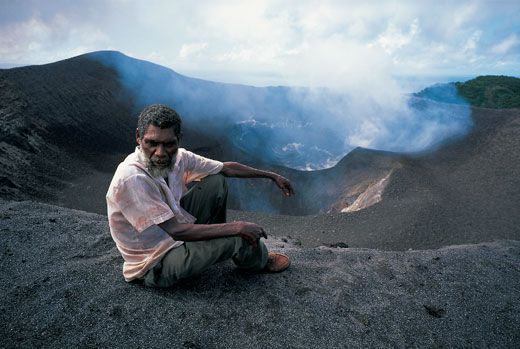
Chief Isaac and other local leaders claim that John Frum first appeared one night in the late 30s after a group of elders had broken many shells of kava as a prelude to receiving messages from the spirit world. "He was a white man who spoke our language, but he didn't tell us he was an American", says the chief Kahuwya, head of the village of Yakel. John Frum told them that he had come to rescue them from missionaries and colonial officials. "John told us that all of Tanna's people should stop following the ways of the white man," Chief Kahuwya says. "He said we should throw away their money and clothes, take our children out of their schools, stop going to church and go back to living as people. kastom. We should drink kava, worship the magic stones and perform our ritual dances».
Perhaps the leaders of their reverie kava they actually experienced a spontaneous vision of John Frum. Or perhaps the apparition has more practical roots. It is possible that local leaders conceived of John Frum as a powerful white-skinned ally in the fight against the colonials, who were attempting to crush much of the culture of the islanders and push them into Christianity. Indeed, that view of the cult's origins gained credence in 1949, when the island administrator, Alexander Rentoul, noting that "frum" is the Tannic pronunciation of "broom", he wrote that the function of John Frum's movement "was to sweep away (or sweep away) all the whites from the island of Tanna".

Whatever the truth, John Frum's message has left its mark. The inhabitants of Tanna began throwing their money overboard and killing their pigs at big parties to welcome their new messiah. Colonial authorities eventually reacted by arresting the leaders of the movement, including Chief Isaac's father, Chief Nikiau. They were sent to a prison in Port-Vila in 1941 and over the years behind bars gained the status of the first martyrs of the John Frum movement. The cult gained its greatest momentum the following year, when thousands of American soldiers were sent to the New Hebrides, where they built large military bases in Port-Vila and on the island of Espíritu Santo. The bases included hospitals, airstrips, docks, roads, bridges and Quonset huts of corrugated steel, many erected with the help of more than a thousand men recruited as laborers from Tanna and other parts of the New Hebrides, including Chief Kahuwya. .
Where the US military goes, the legendary planes also go, with their seemingly endless supply of chocolate, cigarettes and Coke. For men who lived in huts and raised sweet potatoes, the wealth of the Americans was a revelation. The troops paid them 25 cents a day for their work and distributed generous amounts of treats. The munificence of the Americans shocked Tanna's men, as did the sight of dark-skinned soldiers eating the same food, wearing the same clothes, living in similar huts and tents, and operating the same high-tech equipment as the white soldiers. "According to kastom, people sit together to eat, ”says Kirk Huffman, who was the curator of the Vanuatu cultural center during his years in the island nation. "The missionaries had angered the Tannians by always eating separately."
It seems this was the moment when the legend of John Frum took on a decidedly American character. “John Frum appeared to us in Port-Vila,” says Chief Kahuwya, “and he stayed with us throughout the war. John was dressed in white, like the men in the US Navy, and that's when we knew John was an American. John said that when the war was over he would come to us in Tanna in ships and planes carrying a lot of cargo, as the Americans had in Vila ».

In 1943 the United States command, concerned about the growth of the movement, sent the USS Echo to Tanna with Major Samuel Patten on board. His mission was to convince John Frum's followers that, as his report put it, "the American forces had no connection with Jonfrum." Needless to say, hers was a failed mission. At the end of the war, the US military unintentionally added to the legend of their never-ending supply of goods when they scrapped tons of equipment - trucks, jeeps, aircraft engines, supplies - off the coast of the island of Espíritu Santo. For six decades in the shallows, coral and sand have obscured much of the "aquatic grave" of the war surplus, but lovers of snorkeling they can still see tires, bulldozers, and even full Coke bottles. The locals have ironically named the place Million Dollar Points.
After the war, returning home from Port-Vila to their huts, Tanna's men became convinced that John Frum would soon join them and they built a primitive airstrip out of the jungle in the north of the island, to recall the American planes that waited to come from the skies. Across the South Pacific, thousands of other followers of the Cargo Cult began to devise similar plans, building even bamboo control towers to guide planes. In 1964, adepts of a Cargo Cult on New Hanover Island in Papua New Guinea offered the United States government $ 1000 for Lyndon Johnson to come to serve as their supreme leader. But as the years passed and the skies and seas looked desolately empty, most of the cargo cults disappeared and the hopes of the devotees were dashed.
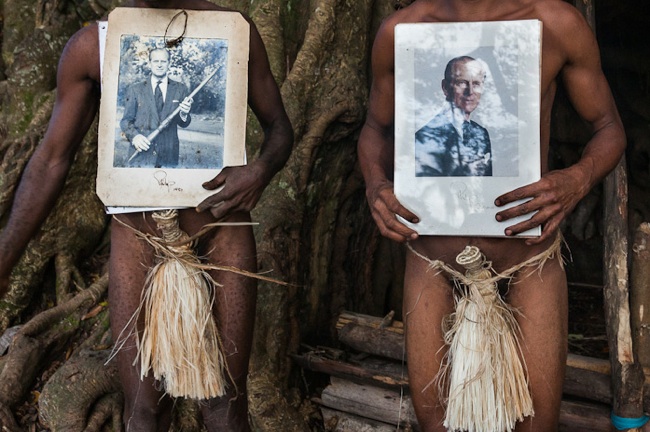
In Sulfur Bay the faithful have never wavered. Every Friday afternoon, hundreds of believers pour into the ash plain below Yasur, arriving in Lamaraka from the villages of Tanna. After the sun goes down and the men have been drinking kava, the congregation gathers in and around a hut built on the ceremonial ground. With the light of kerosene lamps flashing on their faces, attendees play guitars and ukuleles and sing hymns about John Frum's prophecies and the battles of the cult's martyrs. Many make the same request, in unison: “We are waiting for you in our village, John. When are you coming with all the cargo you promised us? ". I look around, in vain, in search of Chief Isaac, until an elder of the sect whispers that he, after drinking kava, Isaac has disappeared into the shaded trees to chat with John Frum. He will have it until the sun rises, that is, until seven the next morning.
The John Frum movement follows the classic pattern of new religions, says anthropologist Huffman. Schisms divide groups of the faithful from the main body, while apostates proclaim a new view that leads to sacrilegious variations on the fundamental beliefs of the creed. This explains the "phenomenon" of the prophet Fred, whose village, Ipikil, is located in Sulfur Bay. Daniel says that Prophet Fred separated from Chief Isaac in 1999 and led half the believers in his new version of the John Frum cult. "He had a vision while working on a Korean fishing boat in the ocean," says Daniel. "God's light fell upon him, and God told him to go home and preach a new way."
People believed that Fred could talk to God after he predicted six years ago that Lake Siwi would break its natural dam and pour into the ocean.. "The people who lived around the lake [on the beach below the volcano] moved to other places," says Daniel. "Six months later, what Fred predicted really happened." Then, nearly two years ago, Prophet Fred's rivalry with Chief Isaac exploded. More than 400 young people from competing villages clashed with axes, bows, arrows and slings, setting fire to a thatched church and several houses. Twenty-five men were seriously injured. “They wanted to kill us, and we wanted to kill them,” says a faithful leader of Isaac.
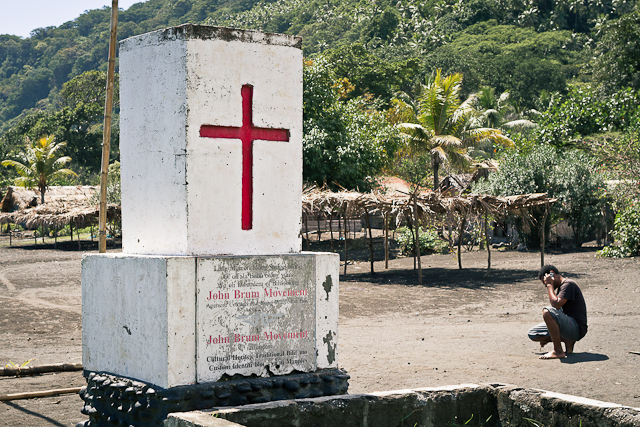
A few days before John Frum's annual Lamakara celebration I visit Prophet Fred's village, only to find that the latter has gone to the northern tip of the island to preach, or more likely to avoid public celebrations. Instead, I meet his senior priest, Maliwan Tarawai, a barefoot pastor carrying a well-bound Bible. “The Prophet Fred called his movement Unity, and has intertwined kastom, Christianity and John Frum together ", Tarawai tells me. The American Messiah is little more than a figurehead in Fred's version of the cult, which prohibits the display of foreign flags, including the Old glory, and prohibits any talk of cargo.
All morning I watch singers with a string band sing hymns about the Prophet Fred, as several feral-eyed women fall into what appears to be a trance. They heal the sick with faith, squeezing the part of the body sick and praying silently to heaven, casting out demons. From time to time they stop motionless and seem to try to cling to the sky with their bony fingers. “They do it every Wednesday, our holy day,” Tarawai explains. "The Holy Spirit has possessed them, they get their healing powers from him and the sun."
Back in Lamakara, John Frum Day is hot and sticky. After the flag is raised, Chief Isaac and the other cult leaders sit on benches shaded by palm fronds, while several hundred followers take turns performing traditional dances or modern improvisations. Men and boys dressed in sewn bark skirts stride the dance floor, clutching replicas of chainsaws carved from the branches of the jungle. Stomping their feet in time with the song, they cut through the air with fake chainsaws. "We came from America to cut down all the trees," they sing, "so we can build the factories."
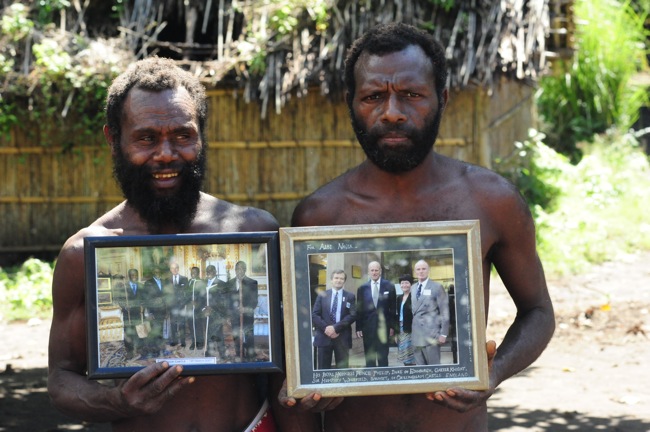
The day before leaving Tanna, Chief Isaac and I finally climb the slippery ash slopes of Yasur, where the ground shakes every ten minutes or so with each thunderous explosion from within the volcanic crater. Each blast that buzzes in the ears throws a huge plume of potentially lethal gas into the sky, a mixture of sulfur dioxide, carbon dioxide and hydrochloric acid. The darkness offers a spectacular view as molten lava erupts from the mouths of the crater, shot into the air in the form of gigantic fireworks. In 1994 two people were killed here by "lava bombs", or pieces of volcanic rock that fell from the sky, coming from the crater. Chief Isaac leads me to a spot on the crumbling edge, away from the outlet of the dangerous gas but still within range of the red-hot bombs.
The chief tells me about his trip to the United States in 1995 and shows me faded photos of himself in Los Angeles, outside the White House and with a drill sergeant on a military base. He says he was amazed by the wealth of the United States, but surprised and saddened by the poverty he saw among white and black Americans, and by the huge spread of guns and drugs, as well as by pollution. He says he's happily returned to Sulfur Bay. "Americans never have smiling faces", he adds, "they always seem to think that death is not far off". When I ask him what he wants most from America, the simplicity of his request moves me: “A 25 horsepower outboard motor for the village boat. So we will be able to catch a lot of fish in the sea and sell it in the market, so that my people can have a better life ».
As we look down into John Frum's blazing abode I remind him that not only does he not have an American outboard motor, but that all other prayers of the devotees have, thus far, been in vain. "John promised you a lot of cargo over 60 years ago, and no one ever came," I stress. "Then why do you keep faith in him? Why do you still believe in him? ". Chief Isaac gives me an amused look. "You Christians have already waited 2000 years for Jesus to return to earth," he replies. "And you haven't lost hope yet."

A comment on "Waiting for John Frum. Vanuatu's “Cargo Cult”"